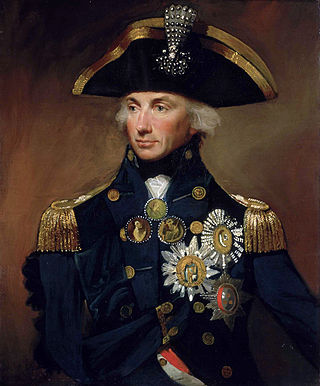
The Missa in angustiis, commonly known as the Nelson Mass, is a Mass setting by the Austrian composer Joseph Haydn. It is one of the six masses written near the end of his life that are seen as a culmination of Haydn's composition of liturgical music.
The Mass No. 13 in B-flat major, Hob. XXII/13, was composed by Joseph Haydn in 1801. It is known as the Schöpfungsmesse or Creation Mass because of the words "qui tollis peccata mundi" in the Gloria. He recycled music from Adam and Eve's final duet in The Creation, a fact which scandalized Empress Maria Theresa so much that she ordered Haydn to recompose that passage for her own copy.

The Missa Sancti Bernardi von Offida is a mass in B-flat major by Joseph Haydn, Hob. XXII:10, Novello 1, was written the same year as the Missa in tempore belli (1796), and it "may have been the first mass Haydn wrote after his return from England." Yet it may also have been the second. It is usually given as Haydn's ninth setting of the mass, though its Hoboken number is XXII:10. This mass was written in honor of St. Bernard of Offida, a Capuchin who devoted himself to helping the poor; a century after the friar's death, he was beatified by Pope Pius VI.
The Harmoniemesse in B-flat major by Joseph Haydn, Hob. XXII:14, Novello 6, was written in 1802. It was Haydn's last major work. It is because of the prominence of the winds in this mass and "the German terminology for a kind of wind ensemble, Harmonie," that this mass setting is called "Harmoniemesse" or "Wind Band Mass". Besides flute, 2 oboes, 2 clarinets, 2 bassoons, 2 horns in B-flat, 2 trumpets in B-flat, the mass also calls for choir, timpani, strings, and organ, the latter supplying figured bass for most of the duration.

The Missa brevis in G major, K. 140, K3 Anh. 235d, K6 Anh. C 1.12, was probably composed by Wolfgang Amadeus Mozart shortly after returning to Salzburg, in March 1773, from his third trip to Italy.
Austrian composer, Michael Haydn's Missa Hispanica or Missa a due cori, Klafsky I:17, MH 422, was presumably written for Spain, but there is no evidence of its ever having been performed there during Haydn's lifetime. The mass is scored for 2 oboes, 2 bassoons, 2 horns in low C, F and G, 2 trumpets in C, timpani, strings, basso continuo, SATB soloists, and two mixed choirs.
Michael Haydn completed the Missa in honorem Sanctae Ursulae, Klafsky 1:18, MH 546, on August 5, 1793, probably for use at the ceremony in which Ursula Oswald, the daughter of a friend, professed her religious vows at the Benedictine Abbey of Frauenwörth Chiemsee. Because of that fact, the Mass is sometimes known as the Chiemsee Mass.
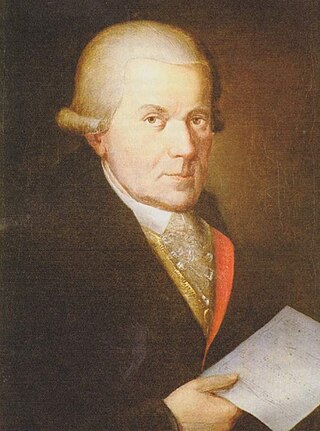
The St. Francis Mass is the shorter name for the Missa sub titulo Sancti Francisci Seraphici composed by Michael Haydn. He completed it on 16 August 1803, apparently at the request of Empress Maria Theresa for a name day celebration.
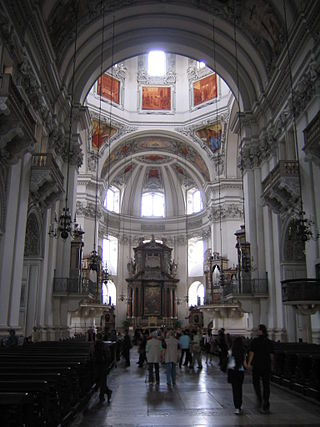
The Missa brevis No. 8 in C major, K. 259, is a mass composed by Wolfgang Amadeus Mozart in 1776. It is scored for SATB soloists, SATB choir, violin I and II, 2 oboes, 2 clarini, 3 trombones colla parte, timpani and basso continuo.
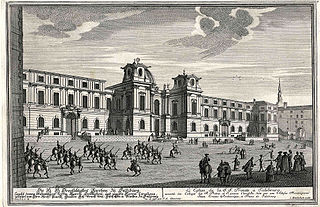
The Missa in honorem Sanctissimae Trinitatis in C major, K. 167, is a mass composed by Wolfgang Amadeus Mozart in June 1773. It is scored for SATB choir, violin I and II, 2 oboes, 2 clarini, 2 trumpets, timpani and basso continuo.

The Credo Mass in C major, K. 257, is a mass composed by Wolfgang Amadeus Mozart in 1776. It is scored for SATB soloists, SATB choir, violin I and II, 2 oboes, 2 clarini, 3 trombones colla parte and basso continuo.

The Missa solemnis in C major, K. 66, is a mass composed by Wolfgang Amadeus Mozart in 1769. It is scored for SATB soloists and choir, violins I and II, viola, 2 oboes, 2 horns, 2 clarini, 2 trumpets and basso continuo.

The Missa brevis in D major, K. 194/186h, is a mass composed by Wolfgang Amadeus Mozart and completed on 8 August 1774. It is scored for SATB soloists, SATB choir, violin I and II, 3 trombones colla parte, and basso continuo.

The Missa brevis No. 7 in C major, K. 258, is a mass composed by Wolfgang Amadeus Mozart in 1776. It is scored for SATB soloists, SATB choir, violin I and II, 2 oboes, 2 clarini, 3 trombones colla parte, timpani and basso continuo.

The Missa longa in C major, K. 262/246a, is a mass composed by Wolfgang Amadeus Mozart in May 1776. Other sources claim it was composed in May 1775. It is scored for SATB soloists, SATB choir, violin I and II, 2 oboes, 2 horns, 2 clarini, 3 trombones colla parte, timpani and basso continuo.
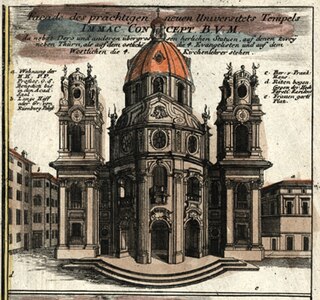
The Missa brevis in D minor, K. 65/61a, is a mass composed by Wolfgang Amadeus Mozart and completed on 14 January 1769. It is scored for SATB soloists and choir, violin I and II, 3 trombones colla parte, and basso continuo.
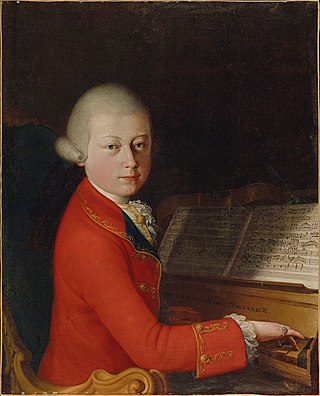
Mozart's Mass in G major, K. 49/47d), is his first full mass. It is a missa brevis scored for SATB soloists and choir, violin I and II, viola, and basso continuo.

Mass No. 1 in F major, D 105, is a mass composed by Franz Schubert in 1814. It is scored for two soprano soloists, two tenor soloists, alto and bass soloists, SATB choir, oboe, clarinet, bassoon, 2 horns, violin I and II, viola, and basso continuo. It was the first of Schubert's masses to be performed, and is of the missa solemnis type.
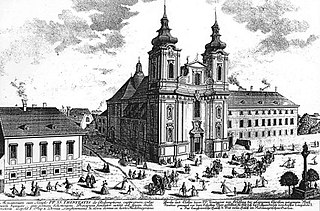
Mass No. 6 in E-flat major, D 950, is a mass composed by Franz Schubert, a few months before his death. It is scored for two tenor soloists, soprano, alto and bass soloists, SATB choir with divisi, 2 oboes, 2 clarinets, 2 bassoons, 2 horns, 2 trumpets, 3 trombones, timpani, violin I and II, viola, cello, and double bass. It was Schubert's final setting of the order of Mass, and is classified as a missa solemnis.
Missa Sancti Nicolai, Mass No. 6 in G major, Hob. XXII/6, also known as the Nicolaimesse, is a mass by Joseph Haydn, composed around 1772 and revised in 1802.












